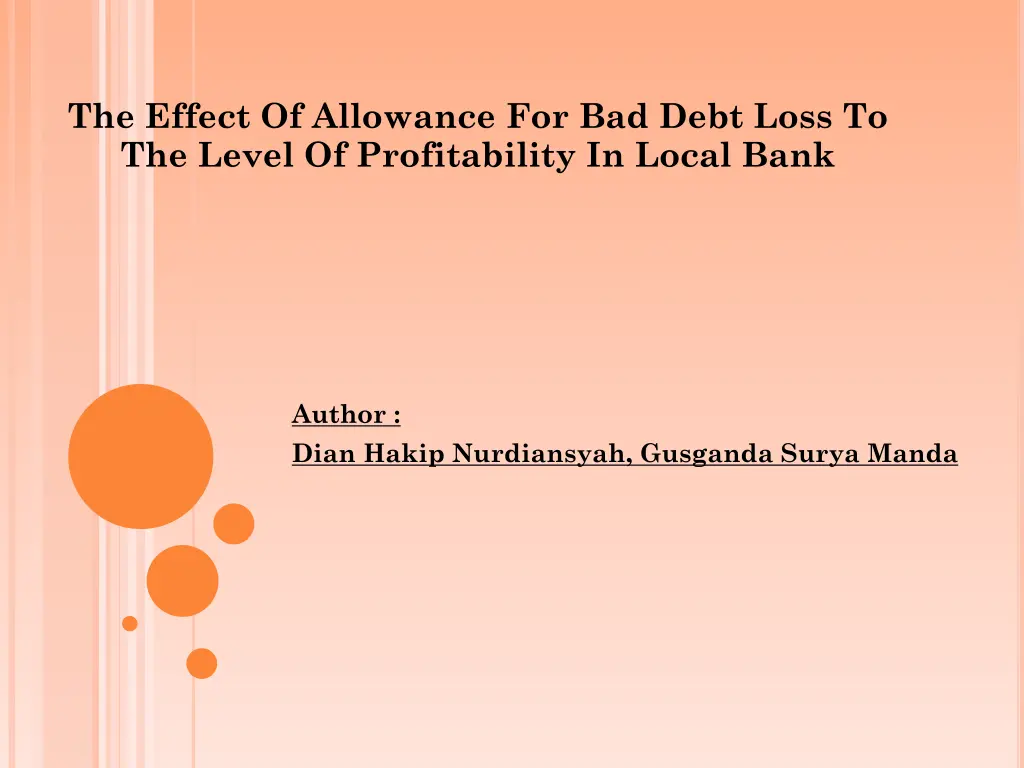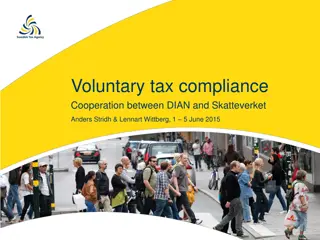
Impact of Allowance for Bad Debt Loss on Bank Profitability
Explore the impact of allowance for bad debt loss on the profitability of local banks in Indonesia post-financial crisis. The study analyzes the relationship between non-performing loans, financial data interpretation, and the level of profitability. Findings indicate significant fluctuations in loan administration and bad debt levels over the years, affecting the overall profitability of banks.
Download Presentation

Please find below an Image/Link to download the presentation.
The content on the website is provided AS IS for your information and personal use only. It may not be sold, licensed, or shared on other websites without obtaining consent from the author. If you encounter any issues during the download, it is possible that the publisher has removed the file from their server.
You are allowed to download the files provided on this website for personal or commercial use, subject to the condition that they are used lawfully. All files are the property of their respective owners.
The content on the website is provided AS IS for your information and personal use only. It may not be sold, licensed, or shared on other websites without obtaining consent from the author.
E N D
Presentation Transcript
The Effect Of Allowance For Bad Debt Loss To The Level Of Profitability In Local Bank Author : Dian Hakip Nurdiansyah, Gusganda Surya Manda
INTRODUCTION The financial crisis that hit Indonesia in mid- 1977 brought a devastating impact on the banking sector in Indonesia. The ratio of non-performing loans became the problems faced by the banking sector due to the condition of the domestic economy that is not yet stable and the strengthening of US dollar. The impact of the large amount of allowance for debt loss has been felt by almost all banks in Indonesia
LITERATURE REVIEW Accounting process of identifying, measuring and reporting economic information to allow for assessment and a clear and unequivocal decision for those who use the information Bank accounting is the accounting process of bank aims for the interest of recording, analyzing, and interpreting of financial data in order to meet the needs of various parties Debt, Loan and profitability
METHODE Collect Data Data were obtained in three ways: first calculating and analyzing the company s annual data that have been taken, the second was to make observations on the development of the company and the third was to hold interviews to the company directly. Descriptive methode with two variable Statistic Analysis
RESULT AND DISCUSSION Coefficientsa Unstandardized Model Standardiz t Sig. Coefficients ed Coefficien ts B Std. Error Beta (Constant) Allowance .681 -7.228 .023 1.472 29.637 -4.910 .000 .000 -.586 1 of Bad Debt a. Dependent Variable: Tingkat Profitabilitas Coefficientsa The result of t testing (Allowance of Bad Debt Loss to the Profitability Level)
RESULT AND DISCUSSION Level of development of loan administration of Subang BPR of Pabuaran branch experienced the largest increase in January 2012 amounted to 17.66% and a significant reduction in December 2015 amounted to -5.04%. Development level of bad debts also increased and decreased, the largest increase was 27.11% in December 2012 and the biggest decrease was in August 2014 amounted to -32.29% this is due to the long holiday that reduced the working days. The development level of allowance for bad debts loss increased significantly by 16.82% in February 2015 and the largest decline was in December 2015 amounted to -39.77%, the amount of allowance for bad debts loss is highly depend on how large the possibility of a credit crunch in the company and the value of collateral pledged on the loan.
RESULT AND DISCUSSION The level of development of loan administration at BPR Subang Branch Pabuaran experienced the largest increase in January 2011 amounted to 17.66% and a significant decline in December 2014 amounted to -5.04%. The level of development of bad debts also increased and decreased, the largest increase was 27.11% in December 2011 and the largest decline was -32.29% in August 2013. It was due to the long feast holiday that reduced working days. The level of development of allowance for bad debt loss increased significantly by 16.82% in February 2014 and the largest decline in December 2014 amounted to -39.77%, greater levels of allowance for debt loss is highly dependent on how large the possibility of a NPL in the the company and the value of collateral pledged on the loan
CONCLUSION The level of allowance of bad debt loss in the Regional Company of Community Bank of Subang of Pabuaran Branch obtained average value at 1.0540. The lowest level of profitability is 0.08% in January 2015. This shows the value of the bank's health from the aspects of profitability in January 2013 and 2014 decreased due to the big percentage of the costs against the low income. The change rate in the amount of total receivables that occurred in BPR Subang of Pabuaran Branch during the period of 2012 2015, there was no significant effect on the level of profitability




